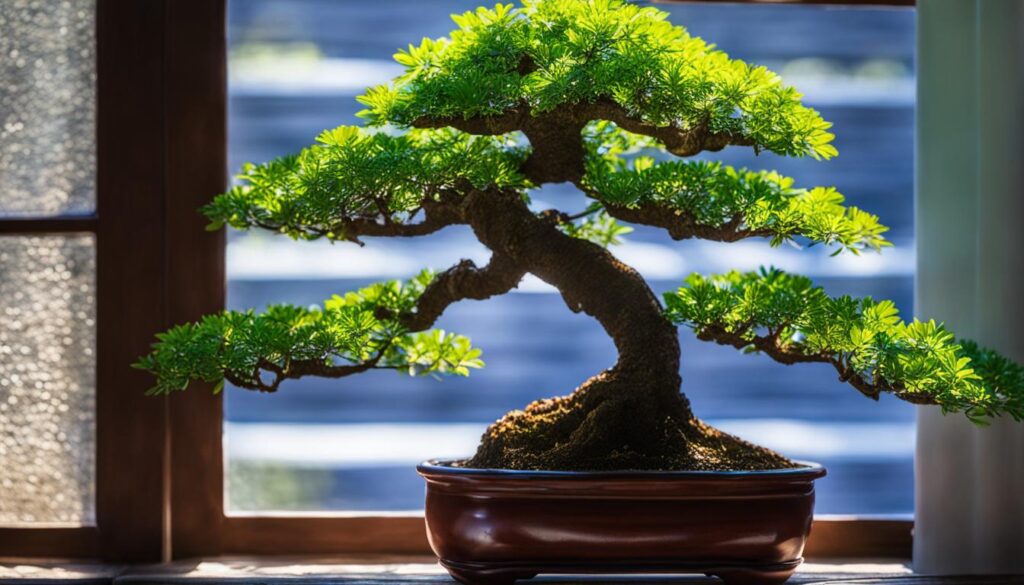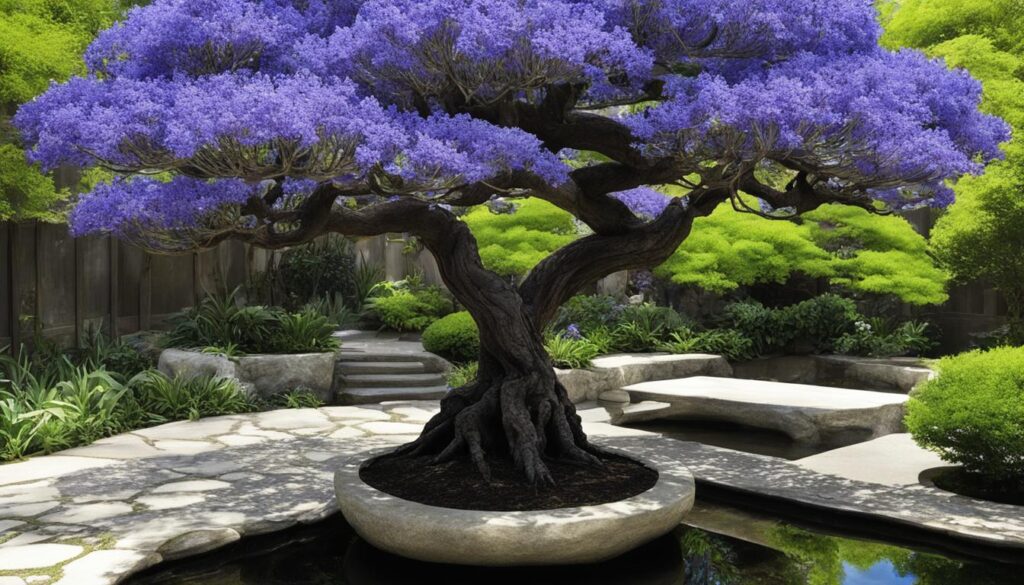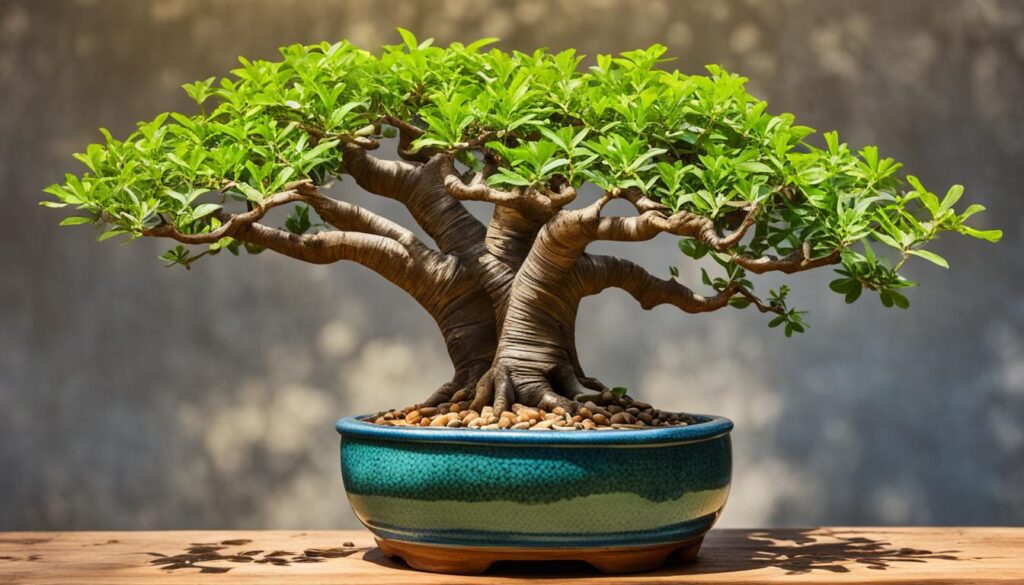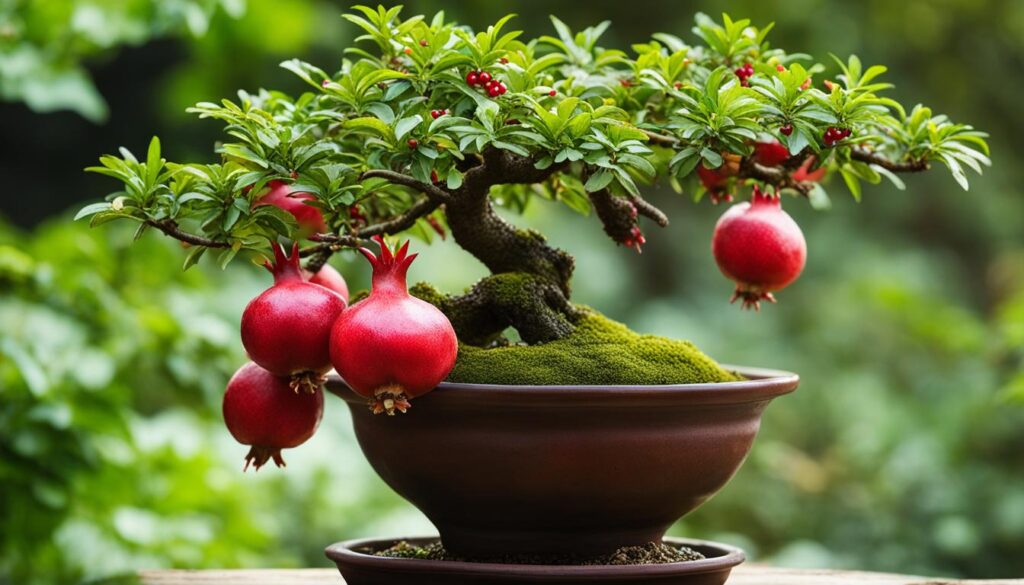If you want to enhance your bonsai collection, the Blue Jacaranda tree is an excellent option. Its vibrant blue or purple flowers and unique fern-like leaves will attract attention.
This guide will help you grow and care for the Blue Jacaranda bonsai. You will learn about its origins, ideal placement, watering needs, soil and fertilizing requirements, pruning, wiring techniques, repotting, and pest management.
Let’s explore the Blue Jacaranda bonsai together!
Do Jacaranda Trees Make Good Bonsai?

Jacaranda trees, especially the Bonsai Blue variety, attract bonsai lovers. They thrive with the right care and produce beautiful purple flowers and fern-like leaves. Good care requires knowledge of specific practices to keep the tree healthy. This guide offers essential tips for the Bonsai Blue Jacaranda, helping you decide if it suits your gardening style.
Must Read: Flame Tree Bonsai (Delonix regia) Growing and Care Guide
An Introduction to Bonsai Blue Jacaranda

The Blue Jacaranda Bonsai, or Jacaranda mimosifolia, is a semi-evergreen tree from South America. This tree has delicate fern-like leaves and beautiful blue or purple flowers. The ‘Bonsai Blue’ variety is a compact dwarf version, making it a popular choice for bonsai hobbyists.
Origins and Uniqueness of Blue Jacaranda Bonsai
The Jacaranda mimosifolia, or Blue Jacaranda, originates from South America. It has intricate leaves and vibrant flowers. The Blue Jacaranda Bonsai replicates the beauty of a full-sized tree in a smaller form, making it appealing to bonsai fans.
Understanding the Dwarf Variety: ‘Bonsai Blue’
The ‘Bonsai Blue’ variety is compact and easy to care for, perfect for smaller spaces. It features fern-like leaves and stunning blooms just like its larger relatives. Its size makes it ideal for bonsai enthusiasts wanting a manageable tree.
Why Blue Jacaranda Bonsai Captures Enthusiasts’ Hearts
The Blue Jacaranda Bonsai captivates bonsai lovers for several reasons. Its delicate leaves add elegance to any collection. The vibrant flowers provide a stunning display when in bloom. Cultivating a miniature version of an exotic tree like the Jacaranda mimosifolia brings joy and fulfillment to enthusiasts.
Average Height of Jacaranda Bonsai
The average height of a Jacaranda Bonsai varies by variety and growing conditions. Full-sized jacaranda trees can grow up to 15 meters tall, while bonsai versions typically range from 1.5 meters to a few feet. The compact size allows for easier care, making it popular with enthusiasts.
Proper Placement for Your Blue Jacaranda Bonsai Tree

Placing your Blue Jacaranda Bonsai correctly is vital for its growth. Consider its light and temperature needs.
The Blue Jacaranda Bonsai thrives in bright light. Place it in a sunny or semi-shaded area to support its growth. This ensures it receives enough light for photosynthesis.
Protect your bonsai from temperatures below 15°C (59°F). Cold can harm its health, so avoid exposing it to freezing conditions. Keep it away from direct hot air from heating devices to prevent damage.
In warmer climates, where temperatures stay above 15°C (59°F), place your Blue Jacaranda Bonsai outside. A sunny spot with good airflow is ideal for its growth. Check the temperature regularly, especially during cooler nights.
Optimal Watering Practices for Bonsai Blue Jacaranda
Proper watering is vital for your Bonsai Blue Jacaranda. Follow these practices to keep your bonsai healthy and vibrant.
Keep the root ball slightly moist. Avoid overwatering or letting the roots dry out, as both can harm the tree.
Regularly check the soil moisture. You can test it by poking your finger into the soil. If it feels moist, wait before watering. If it feels dry, water the tree.
Watering frequency can change due to temperature, humidity, and the specific needs of your bonsai. Generally, bonsai trees need watering every 2-3 days, but adjust as necessary.
Here are some tips to maintain optimal watering for your Bonsai Blue Jacaranda:
- Use a gentle watering can or spray nozzle to avoid disturbing the roots.
- Water thoroughly, ensuring water reaches the entire root system.
- Avoid stagnant water in the saucer, as it can lead to root rot.
- In hot weather, mist the leaves regularly to increase humidity.
Proper watering requires balance. Pay attention to soil moisture and adjust your watering frequency. With consistent care, your Bonsai Blue Jacaranda will thrive.
For a visual guide on watering practices, refer to the table below:
The Importance of Soil and Fertilizing for Jacaranda mimosifolia Bonsai

The soil type and fertilization for your Blue Jacaranda Bonsai are crucial for its growth. A well-draining soil mix with nutrients is necessary for a healthy bonsai.
For your blue jacaranda soil, create a mixture that promotes healthy root growth. A bonsai soil mix designed for jacaranda bonsai is ideal. This mix should combine organic potting soil, perlite, and crushed granite. The potting soil offers nutrients, while perlite and granite ensure good drainage.
Soil drainage is vital for blue jacaranda bonsai, as they prefer slightly acidic to neutral soil. Poor drainage can cause root rot and other issues. Select a soil mix that allows excess water to flow freely.
For fertilizing, use a balanced liquid fertilizer during the growing season. This fertilizer provides essential nutrients for growth. Follow the instructions carefully and avoid over-fertilizing to prevent root burn.
It is also recommended to use a slow-release fertilizer in spring. This method offers a steady nutrient supply, supporting long-term health for your blue jacaranda bonsai.
| Soil Composition | Benefits |
|---|---|
| Organic potting soil | Provides essential nutrients |
| Perlite | Improves drainage |
| Crushed granite | Enhances aeration |
By providing suitable soil and proper fertilization, you create an ideal environment for your Blue Jacaranda Bonsai. This supports its growth and vibrant blooms.
Pruning and Wiring Your Jacaranda Plant
Pruning and wiring techniques are crucial for shaping your Blue Jacaranda Bonsai. Regular pruning controls growth and encourages branching, while wiring helps shape the branches.
To prune your Jacaranda Bonsai, identify overgrown branches. Use clean and sharp bonsai shears to cut just above a leaf node or bud. Remove dead or crossing branches to maintain health and appearance.
When wiring, use flexible bonsai wire that suits the branch thickness. Wrap the wire around the branch gently, starting at the base. Avoid wrapping too tightly to prevent damage. Shape the branch by bending it carefully. The wire should stay in place for several months until the branch holds its shape. Check the wire regularly to ensure it’s not cutting into the branch.
Be careful with pruning and wiring to avoid stressing your Jacaranda Bonsai. Understand the growth patterns to adjust your techniques and achieve the desired form.
When and How to Repot Jacaranda mimosifolia

Repotting is vital for bonsai care, including the Blue Jacaranda Bonsai. It refreshes the soil, prunes roots, and promotes the overall health of the tree.
To determine when to repot, consider these factors:
- Growth rate: Repot younger trees every 1-2 years. Mature trees may only need repotting every 3-5 years.
- Root system: Check the roots by removing the tree from its pot. If the roots are dense and circling, it’s time to repot.
- Season: Repot in spring or early summer when the tree is actively growing.
Follow these steps to repot your Blue Jacaranda Bonsai:
- Choose a slightly larger pot with good drainage.
- Add a layer of bonsai soil mix to the new pot.
- Gently remove the tree from its pot, avoiding root damage.
- Trim the roots to promote new growth and maintain balance.
- Place the tree in the new pot, spreading the roots evenly.
- Add bonsai soil mix around the roots, firming it gently.
- Water thoroughly, allowing excess to drain.
- Place the repotted bonsai in a shaded area for recovery.
By following these repotting steps and using an appropriate soil mix for repotting, you can support the growth of your Blue Jacaranda Bonsai.
Blue Jacaranda: Dealing with Pests and Ensuring Healthy Blooms
Maintaining the health of your Blue Jacaranda Bonsai is vital. Like all plants, it is vulnerable to pests and diseases. Understanding common pests and proactive pest management can help you achieve healthy blooms and vibrant foliage.
Common pests include aphids, whiteflies, and mealybugs. These insects can damage leaves and hinder growth. Use organic pest control methods like insecticidal soap or neem oil. Regularly check your bonsai and treat infestations promptly.
To ensure healthy blooms, provide adequate sunlight, water, and nutrient-rich soil. Your tree needs at least 6 hours of sunlight daily without scorching its leaves.
Water carefully to avoid both over and under-watering. Monitor moisture levels and adjust your watering frequency. Use a well-draining soil mix and fertilize during the growing season to provide necessary nutrients. These practices will help your Blue Jacaranda Bonsai thrive and produce stunning blooms.
Discover the Most Stunning Bonsai Christmas Tree This Holiday Season! >>>



